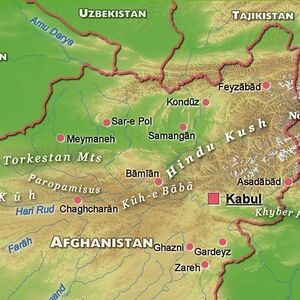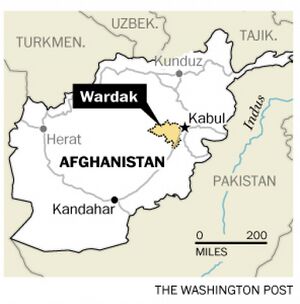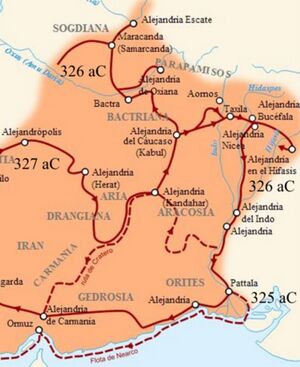Ortospana
| Author:Laxman Burdak, IFS (R) |



Ortospana was an ancient city of Bactriana, which is supposed to be identical with the modern town of Kabul.[1][2][3][4] The name Ortospana alone is found in records of Strabo (63/64 BC – ca. AD 24) and Pliny (23–79 AD).
Alexander Cunningham[5] has identified Ortospana with Varadasthana, the place occupied by Wardak clan in Afghanistan. Wardak is also the name of a province of Afghanistan.
Variants
- Ortospana (Greek: Ὀρτόσπάνα)
- Cabura (Greek: Κάβουρα)
- Kabura
- Ortospanum
- Orthospanum
- Urddhasthana (Sanskrit उर्द्धस्थान) = the " high place," or lofty city.
- Varadasthana (वरदस्थान), अफगानिस्तान, (AS, p.832)
Jat Gotras Namesake
- Burdak = Vardak = Varadasthana = Ortospana (Greek: Ὀρτόσπάνα) (Pliny.vi.21)[6][7]
Mention by Pliny
Pliny[8] mentions 'The Nations of India'....However, that we may come to a better understanding relative to the description of these regions, we will follow in the track of Alexander the Great. Diognetus and Bæton, whose duty it was to ascertain the distances and length of his expeditions, have written that from the Caspian Gates to Hecatompylon, the city of the Parthians, the distance is the number of miles which we have already12 stated; and that from thence to Alexandria,13 of the Arii, which city was founded by the same king, the distance is five hundred and seventy-five miles; from thence to Prophthasia,14 the city of the Drangæ, one hundred and ninety-nine; from thence to the city of the Arachosii,15 five hundred and sixty-five; from thence to Ortospanum,16 one hundred and seventy-five; and from thence to the city built by Alexander,17 fifty, miles. In some copies, however, the numbers are found differently stated; and we find this last city even placed at the very foot of Mount Caucasus!
13 See c. 25 of the present Book.
14 See c. 25 of the present Book.
15 See c. 25 of the present Book.
16 A town placed by Strabo on the confines of Bactriana, and by Ptolemy in the county of the Paropanisidæ.
17 See c. 25 of the present Book.
History
The name is written variously in ancient authors Ortospana or Ortospanum; the latter is the form adopted by Pliny.[9] Three principal roads leading through Bactriana met at this place; hence the notice in Strabo of the ἡ ἐκ Βάκτρον τρίοδος.[10] The three roads may be, the pass by Bamian, that of the Hindu Kush, and that from Anderab to Khawar.[11]
Alexander Cunningham[12] writes about Kophene, or Kabul: The district of Kabul is first mentioned by Ptolemy, who calls the people Kubolitaea, and their capital Kabura, [p.33]: which was also named Ortospana. The latter name alone is found in Strabo and Pliny, with a record of its distance from the capital of Arachosia, as measured by Alexander's surveyors, Diognetes and Baiton. In some copies of Pliny the name is written Orthospanum, which, with a slight alteration to Orthostana, as suggested by H. H. Wilson,[13] is most probably the Sanskrit Urddhasthana, that is, the " high place," or lofty city. The same name is also given to the Kabul district by the Chinese pilgrim Hwen Thsang. But I strongly suspect that there has been some accidental interchange of names between the province and its capital.
The name of the capital, as given by the Chinese pilgrim, has been rendered by M. Vivien de St. Martin as Vardasthana, and identified with the district of the Wardak tribe, while the name of the province has been identified with Hupian or Opian. But the Wardak valley, which receives its name from the "Wardak tribe, lies on the upper course of the [p.34]: Logarh river, at some distance to the south, of Kabul, and only 40 miles to the north of Ghazni, while Hupian or Opian lies 27 miles to the north of Kabul, or more than 70 miles distant from Wardak. My own researches lead me to conclude that both names refer to the immediate neighbourhood of Kabul itself.
Visit by Xuanzang 630 AD & 644 AD
Alexander Cunningham[14] writes about Kophene, or Kabul: The district of Kabul is first mentioned by Ptolemy, who calls the people Kubolitaea, and their capital Kabura,
[p.33]: which was also named Ortospana. The latter name alone is found in Strabo and Pliny, with a record of its distance from the capital of Arachosia, as measured by Alexander's surveyors, Diognetes and Baiton. In some copies of Pliny the name is written Orthospanum, which, with a slight alteration to Orthostana, as suggested by H. H. Wilson,[15] is most probably the Sanskrit Urddhasthana, that is, the " high place," or lofty city. The same name is also given to the Kabul district by the Chinese pilgrim Hwen Thsang. But I strongly suspect that there has been some accidental interchange of names between the province and its capital.
On leaving Ghazni, the pilgrim travelled to the north for 600 li, or 83 miles, to Fo-li-shi-sa-tang-na, of which the capital was Hu-phi-na. Now by two different measured routes the distance between Ghazni and Kabul was found to be 81 and 88½ miles.[16] There can be no doubt, therefore, that Kabul must be the place that was visited by the pilgrim. In another place the capital is said to be 700 li, or 116 miles, from Bamian, which agrees very well with the measured distance of 104 miles[17] between Bamian and Kabul, along the shortest route.
The name of the capital, as given by the Chinese pilgrim, has been rendered by M. Vivien de St. Martin as Vardasthana, and identified with the district of the Wardak tribe, while the name of the province has been identified with Hupian or Opian. But the Wardak valley, which receives its name from the "Wardak tribe, lies on the upper course of the
[p.34]: Logarh river, at some distance to the south, of Kabul, and only 40 miles to the north of Ghazni, while Hupian or Opian lies 27 miles to the north of Kabul, or more than 70 miles distant from Wardak. My own researches lead me to conclude that both names refer to the immediate neighbourhood of Kabul itself.
Professor Lassen has already remarked that the name of Kipin, which is so frequently mentioned by other Chinese authors, is not once noticed by Hwen Thsang. Remusat first suggested that Kipin was the country on the Kophes or Kabul river ; and this suggestion has ever since been accepted by the unanimous consent of all writers on ancient India, by whom the district is now generally called Kophene. It is this form of the name of Kipin that I propose to identify with the Hu-phi-na of Hwen Thsang, as it seems to me scarcely possible that this once famous province can have remained altogether unnoticed by him, when we know that he must have passed through it, and that the name was still in use for more than a century after his time.[18] I have already stated my suspicion that there has been some interchange of names between the province and its capital. This suspicion is strengthened when it is found that all difficulties are removed, and the most complete identification obtained, by the simple interchange of the two names. Thus Hu-phi-na will represent Kophene, or Kipin, the country on the Kabul river, and Fo-li-shi-sa-tang-na, or Urddhasthana, will represent Ortostana, which, as we know from several classical authorities, was the actual capital of this province.
[p.35]: I may remark that Huphina is a very exact Chinese transcript of Kophen, whereas it would be a very imperfect transcript of Hupian, as one syllable would be altogether unrepresented, and the simple p would be replaced by an aspirate. The correct transcript of Hupian would be Hu-pi-yan-na.
M. Vivien de St. Martin has objected[19] to the name of Urddhasthana that it is a " conjectural etymology without object." I am, however, quite satisfied that this reading is the correct one, for the following reasons : — 1st. The name of Ortospana is not confined to the Paropamisadae ; but is found also in Karmania and in Persis. It could not, therefore, have had any reference to the Wardak tribe, but must be a generic name descriptive of its situation, a requirement that is most satisfactorily fulfilled by Urddhasthana, which means literally the "high place," and was most probably employed to designate any hill fortress. 2nd. The variation in the reading of the name to Portospana confirms the descriptive meaning which I have given to it, as porta signifies "high " in Pushtu, and was, no doubt, generally adopted by the common people instead of the Sanskrit urddha.
The position of Ortospana I would identify with Kabul itself, with its Bala Hisar, or "high fort," which I take to be only a Persian translation of Ortospana, or Urddhasthana. It was the old capital of the country before the Macedonian conquest, and so late as the tenth century it was still believed " that a king was not properly qualified to govern until he had been inaugurated at Kabul."[20] Hekataeus also describes
[p.36]: a " royal town " amongst the Opiai,[21] but we have no data for determining either its name or its position. It seems most probable, however, that Kabul must he intended, as we know of no other place that could have held this position after the destruction of Kapisa by Cyrus ; but in this case Kabul must have been included within the territories of the Opiai.
It is strange that there is no mention of Kabul in the histories of Alexander, as he must certainly have passed through the town on his way from Arachosia to the site of Alexandria. I think, however, that it is most probably the town of Nikaia, which was Alexander's first march from his new city on his return from Bactria. Nikaia is described by Nonnus as a stone city, situated near a lake. It was also called Astakia, after a nymph whom Bacchus had abused.[22] The lake is a remarkable feature, which is peculiar in Northern India to Kabul and Kashmir. The city is also said to have been called Indophon, or "Indian-killer," on account of the victory which Bacchus had gained over the Indians on this spot. From this name I infer, that Nonnus had most probably heard of the popular meaning which is attributed to the name of Hindu-kush, or "Hindu-killer," and that he adopted it at once as corroborative of the Indian conquests of Dionysius.
[p.37]: The province is described as being 2000 li, or 333 miles, in length, from east to west, and 1000 li, or 166 miles, in breadth from north to south. It is probable that this statement may refer to the former extent of the province, when its king was the paramount ruler of Western Afghanistan, including Ghazni and Kandahar, as the actual dimensions of the Kabul district are not more than one-half of the numbers here stated. Its extreme length, from the sources of the Helmand river to the Jagdalak Pass, is about 150 miles, and its extreme breadth, from Istalif to the sources of the Logarh river, is not more than 70 miles.
The name of Kophes is as old as the time of the Vedas, in which the Kubha river is mentioned as an affluent of the Indus ; and as it is not an Arian word, I infer that the name must have been applied to the Kabul river before the Arian occupation, or, at least, as early as B.C. 2500. In the classical writers we find the Khoes, Kophes, and Khoaspes Rivers, to the west of the Indus, and at the present day we have the Kunar, the Kuram, and the Gomal rivers to the west, and the Kunihar river to the east of the Indus, all of which are derived from the Scythian ku, " water." It is the guttural form of the Assyrian hu in Euphrates and Eulaeus, and of the Turki su and the Tibetan chu, all of which mean water or river. The district of Kophene must, therefore, have received its name from the river which flowed through it, like as Sindh from the Sindhu or Indus, Margiana from the Margus, Aria from the Arius, Arachosia from the Arachotus, and others. It is not mentioned by Alexander's historians, although the river Kophes is noticed by all of them.
[p.38]:In Ptolemy's ' Geography ' the city of Kabura and the Kabolitae, with the towns of Arguda, or Argandi, and Locharna, or Logarh, are all located in the territories of the Paropamisadae along the Kabul river. Higher up the stream he places the town of Bagarda, which corresponds exactly in position, and very closely in name with the valley of Wardak. All the letters of the two names are the same; and as the mere transposition of the guttural to the end of the Greek name will make it absolutely identical with the modern name, there is strong evidence in favour of the reading of Bardaga instead of Bagarda. According to Elphinstone,[23] the Wardak tribe of Afghans occupy the greater part of the Logarh valley. This is confirmed by Masson,[24] who twice visited the district of "Wardak ; and by Vigne,[25] who crossed it on his way from Ghazni to Kabul. The only objection to this identification that occurs to me is, the possibility that Bagarda may be the Greek form of Vackereta, which is the name given in the ' Zend Avesta ' to the seventh country that was successively occupied by the Arian race. From its position between Bactria, Aria, and Arachosia, on one side, and India on the other, Vackereta has usually been identified with the province of Kabul. This, also, is the opinion of the Parsis themselves. Vackereta is further said to be the seat or home of Duzhak, which further tends to confirm its identification with Kabul, as the acknowledged country of Zohak. If the Wardaks had ever been a ruling tribe, I should be disposed to infer that the name of Vackereta might, probably, have been derived from them. But in our present total ignorance
[p.39]: of their history, I think that it is sufficient to note the very great similarity of the two names.
In the seventh century the king of Kophene was a Turk, and the language of the country was different from that of the people of Ghazni. Hwen Thsang mentions that the alphabet of Kapisene was that of the Turks, hut that the language was not Turki. As the king, however, was an Indian, it may reasonably be inferred that the language was Indian. For a similar reason it may be conjectured that the language of Kophene was some dialect of Turki, because the king of the district was a Turk.
Jat History
Bhim Singh Dahiya[26] has mentioned about a inscription of Wardak (Wardak Vase Inscription 129 AD see Wardak) near Kabul of the year 51 of Saka era, which relates the establishment of the relic of Lord Buddha in a stupa by Vagramarega who is shown as a scion of Kama Gulya. Here it is related with clan name Gulya of the Jats. Wardak is associated with the history of Burdak Jat clan.
वरदक
वरदक (AS, p.832): अफ़ग़ानिस्तान का एक प्रान्त है। यहाँ पर एक प्राचीन बौद्ध स्तूप स्थित है, जिसमें एक पीतल के घड़े पर 6 ई. पू. का एक अभिलेख प्राप्त हुआ है। प्रसिद्ध चीनी यात्री युवानच्वांग (जिसका भारत भ्रमण काल 630-645 ई. है।) ने इस स्थान का उल्लेख वर्तमान ग़ज़नी से 40 मील पर किया है। युवानच्वांग के अनुसार यहाँ का राजा तुर्की बौद्ध था। इसे 'वरदस्थान' भी कहा जाता है।[27]
See also
References
- ↑ Vaux, W. S. W. (1857). "Ortospana". In Smith, William (ed.). Dictionary of Greek and Roman Geography. Vol. 2: Iabadius–Zymethus. London: Walton and Maberly. pp. 497–498. Public Domain This article incorporates text from this source, which is in the public domain.
- ↑ Strab. xi. p. 514, xv. p. 723; κάρουρα ἡ καὶ Όρτόσπάνα.
- ↑ Ptol. Geog. vi. 18. § 5.
- ↑ Amm. Marc. xxiii. 6.
- ↑ [[Alexander Cunningham]]: The Ancient Geography of India/Kabul,pp. 32-34
- ↑ Bhim Singh Dahiya:Jats the Ancient Rulers (A clan study)/The Jats, p.41
- ↑ [[Alexander Cunningham]]: The Ancient Geography of India/Kabul,pp. 32-34
- ↑ Natural History by Pliny Book VI/Chapter 21
- ↑ Plin. NH. vi. 17. s. 21.
- ↑ Strab. xi. p. 514, xv. p. 723.
- ↑ Vaux 1857, pp. 497–498.
- ↑ The Ancient Geography of India/Kabul,pp. 32-34
- ↑ 'Ariana Antiqua,' p. 176.
- ↑ The Ancient Geography of India/Kabul,pp. 32-39
- ↑ 'Ariana Antiqua,' p. 176.
- ↑ Thornton's ' Gazetteer,' Appendix.
- ↑ Lieutenant Sturt, Engineers, by perambulator.
- ↑ Lassen, ' Points in the History of the Greek Eings of Kabul,' p. 102.
- ↑ 'Hiouen Thsang,' iii. 416.
- ↑ Ouseley, ' Oriental Geography,' p. 226.
- ↑ Steph. Byz. in v. 'Ωπiai.'<greek>
- ↑ 'Dionysiaca,' xvi. <greek> The meaning of which appears to be, that " Bacchus built a stone city, named Nikaia, near a lake, which he also called Astakia, after the nymph, and Indophon, in remembrance of his victory."
- ↑ Kabul; i. 160.
- ↑ ' Travels,' ii. 223.
- ↑ ' Ghazni,' p. 140.
- ↑ Bhim Singh Dahiya:Jats the Ancient Rulers (A clan study)/The Jats, p.41
- ↑ Aitihasik Sthanavali by Vijayendra Kumar Mathur, p.832

